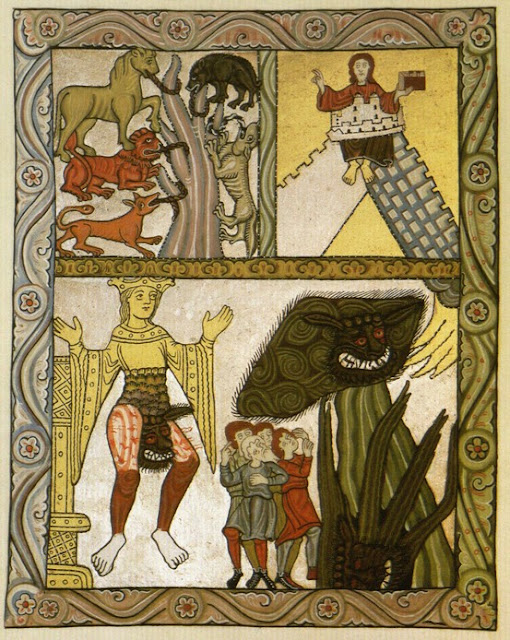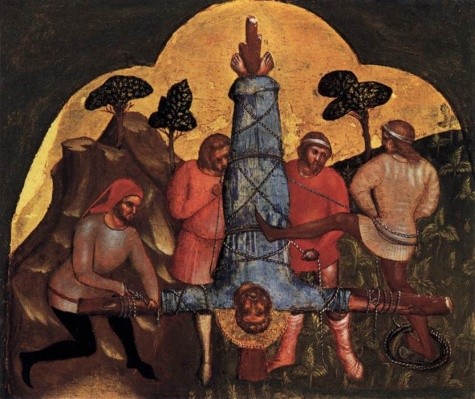Monday, April 30, 2012
Friday, April 27, 2012
I feel like Donestre
I do have some weird fascination with monsters; I still throw a glance at my wardrobe to make sure that there is no Boogieman before going to
sleep.
 |
| The Boogieman found on the Madrid Fashion Week 2009 catwalk. |
The word ‘Monster’ is believed to come from the Latin monstro
meanings ‘to show’, ‘to demonstrate’, the idea being that monsters show outside
themselves. Maybe it is because they are meant to be signs that they are so
easy to relate to. Despite the almost 1000 year gap between the scribe of Marvels
of the East manuscript and me and the fact that the monsters and concerns
of 21st century are different from 1050, I found myself relating to
this guy:
 |
| Donestre weeping over the head, Notice the look of pity and guilt. |
Donestre were believed to be multilingual and when travelers came across them they would greet foreigners in their language. Once they gained the travelers trust they devoured their body. And then in a radical display of consciousness they would weep over the disembodied head.
I find this story touching and right now Donestre can be the symbol of my day, no not because I devoured someone. Well I did devour far to many sweets and now I am sitting surrounded by wrappers stirring in my own guilt. So Donestre can be a symbol of everyone who regrets eating too much too soon.
Another reason is that I was really looking forward to studying today as I have an awesome book to read, yet after switching on the computer I spent half of the day procrastinating. and now I keep looking at the time, the book and the computer guilty of my laziness. And I know that while its weeks till the exam I will be happily procrastinating ( Donestre devouring the body) once its down to days I will feel guilty and spend the rest of the time until exam blaming myself ( Donestre crying over the head).
Jenny
Book of the day: Debra H. Strickland, Saracens, Demons and Jews, Princeton, N.J. ; Oxford : Princeton University Press, 2003.
Labels:
1050,
art,
art and christianity,
art and popular culture,
christianity,
christianity and culture,
Denestre,
history of art,
jenny judova,
marginal,
Marvels of the east,
Monsters,
monsters in popular culture,
the devil,
the devil research,
the other
Thursday, April 26, 2012
The Cathedral car trip: East Coast of England
In less than a month my exams end and I will be celebrating this with a car trip from Glasgow to London through the churches on the East coast of England.
So far the stops are as follows:
1) Rosslyn chapel (yes the lovely 15th century church that was mentioned in the-book-that-should-not-be-named)
2) Jedburgh abbey
3) Hexham Abbey
4) Corbridge (has Roman ruins)
5) Newcastle
6) Durham
7) Fountains Abbey (the abbey I am dying to see since second year)
8) Harrogate
9) York
10) Gimsby (a church closely connected with Lincoln cathedral by a legend)
11) Lincoln
12) Norwich
13) Ely
14) Canterbury
JennyTuesday, April 24, 2012
Why the Devil, why not God? Or Historical Jesus ramblings
I lack the words to phrase my
answer delicately so I will put it bluntly: because God in art is boring and
painful. Of course there are a couple of fascinating images from pictorial,
theological and narrative perspectives, especially those of the Trinity such
as:
 |
| Abraham
before the Trinity, St John’s Psalter, (England, c. 1270-80) Cambridge, St John’s College Library, MS K.26, fol. 9 |
However the cool stuff was destroyed by iconoclasts and the representations of god became normalized [thank you Luther and Council of Trent *dripping with sarcasm* I also love the bitter irony – Christians smashed images of god yet preserved those of the devil – kill god and save the devil] The images of God that we have in their majority are either cringingly painful such as Grünewald’s Isenheim Altarpiece or chocolate box kitsch such as Warner Sallman's Head of Christ.
 |
| M. Grünewald, Isenheim Altarpiece, 1506-1515 |
 |
M. Grünewald, Isenheim Altarpiece, 1506-1515 (detail)
|
 |
| Warner Sallman, Head of Christ, 1941. |
The second reason is that I do
not want to go crazy; the devil belongs to theology and various art forms yet
not to history. Moreover previous scholars when writing on him were not
invested in the Devil or the idea of him. Therefore, I can hope to find
objectivity in the writings. God on the other hand is an academic nightmare as
scholars are often invested in proving or disproving something about him,
people are touchy and get easily upset when it comes to god. The worst part
about god (at least in Christianity) is that his realm is not only theology and
art but also history. And by history I do not just mean the vague abstract idea
that God acts out in history from time to time, but that he at one point was
physically present on earth in flesh ad blood and named Jesus. Studying
historical Jesus this year has given me a taste of the student’s nightmare that
God can turn in to.
Jesus is a pain all over. First
of all there are the sources or better say their absence. Outside the New
Testament not much is written; there is Josephus yet the two tiny passages
where he does mention Jesus where heavily edited by Christians. If the
Christian additions are stripped it says that he was a teacher who was followed
by Jews and Greeks, he was crucified under Pilate (Jewish Antiquities 18:63 and
in the passage 20:200 we are told that James had a brother ‘Jesus who was
called the Christ’. Tautus in his Annals writes that Jesus was executed during
Tiberius’ reign by the governor of Judea ,
Pontius Pilate (Annals 15:44), he also talks about Christian persecution by
Nero but he does not seem to know the groups beliefs and teachings. Pliny the
Younger and Lucian of Samosata take a more satirical approach as they laugh at
Christian conventions. In all these cases we are told more about the early
Christians, Jesus is known not by what he was but by what his followers have
become. The only thing that we find in these witnesses about Historical Jesus
is that he was crucified during Pilate’s reign . Crucifixion under Pontius Pilate
is one of the very few widely attested events and we can say that most
plausibly it did happen. Moreover it fits with Pilate’s regime as he ‘was
eventually dismissed from office as a result of a large number of executions
without trial that took place on his watch.’ ( E.P. Sanders as quoted in M.A.
Powell, Jesus as a figure in History, (Westminster :John
Knox Press,U.S.
Yet it gets worse. Our main
source for Historical Jesus is the New Testament that is book s written by his
followers. The earliest of these are the epistles of Paul. The problem with
these is that there are Pauline epistles and there are pseudo Pauline epistles
and scholars are not always sure which ones are which. Yet even if we know which are Paul’s another
problem arises - Paul does not seem to care for historical Jesus he does not
say what he did or what he systematically taught. Yet there are a few valuable
passages 1 Corinthians 7:10 which affirm the marriage rites in Mark 10:2-12,
Romans 12:14-21 affirms some of the Sermon on the Mount teachings (Matt 5:38-48).
Also he gives evidence that by the time he wrote in around 50 CE the following traditions
were established: Lords Supper (1 Corinthians 11:23-26), 12 disciples (1 Corinthians
15) and the descendents from David (Romans 1 :3). Non Pauline letters also
offer very little evidence and they are less valuable then Pauline because
their composition is latter hence it might be dependant on the gospel
tradition.
Of course the main sources for
the study of Jesus are the four gospels. However there are problems with these
four. John is the last to be written and is theologically developed thus it is
not the historical Jesus that is found there but a rethought historical Jesus
which helps support John’s theology with his deeds. The synoptics are the
biggest source of our information on Jesus. They are still fairly close to the
historical Jesus (they come from the third generation what means that they
could have used actual witness accounts). The eldest of these is Mark (c. 60-70
CE). Theologically it is undeveloped; this is especially seen in the lack of
the birth and resurrection narratives. Mark, as textual evidence show, was most
probably known to Luke and Matthew who heavily relied on it. Most of Mark is
found in these two latter gospels. Moreover it was not only Mark that they had
a common source but based on the amount of material that is identical in the
two yet not found in Mark it is believed that they shared a document now known
as Q (Quelle on German –
source). All this creates another
problem as when something is attested in all three gospels it can not be
counted as a 3 time attestation as it can all be derived from a single source (Mark)
or two sources (Mark and Q).
Will the Real
Historical Jesus please stand up!
Each successive epoch of theology found its own thought in Jesus …But
it was not only each epoch that found its reflection in Jesus; each individual
created him in according to his own character.
A.Schweitzer
The following is a llist of the leading Historical Jesus scholars and their summarised views on Jesus informed by their own works and teh summary on each one of them found in Allan Powells book. The mojar reason why their views diverge so drastically id their choice of criteria and their decision of how to date which source (in other words what prority to give to each source.
Sanders
Eschatological apocalyptic
radical Jewish prophet (who possibly believed that he has a role to play in
the coming Kingdom). Believed in the immediate coming of the kingdom his aim
was to get as many people to God as possible. This idea was so prevalent
that he did not even require the sinners to repent, their membership was enough
to grant them access to the kingdom
of God
Crossan
Cynic Mediterranean (Hellenistic) non-escatological
peasant who is rethinking peasant society.
Believes that the apocalyptic was
read in to Jesus and his deeds after the destruction of the temple. Yet at the
same time he takes up Sanders’ position on Jesus last week, with teh exeption that e does not include teh resurection and argues that no one knows where he is buried
most likely his corpse was eaten by wild animals.
He does give an interesting a
plausible explanation to why Christianity became the majority religion. He
states that exclusive Judaism became Rabbinical Judaism whereas inclusive
Judaism in to Early Christianity.
Vermes
Jewish Holy man (Jewish charismatic), did not reach out to gentiles (Matthew 15:24, 10:6). Learnt man,
exorcist, healer, teacher. Exorcism and
healing = confirmation of his teachings and power as in the first century God had a monopoly on healing as an illness was a sign of sin or devil's work. (Vermes 1973)
Bultman
Jesus distinguishes himself from the Son of Man. Kingdom is
entirely in the future yet determines the present.
Le Donne
Jesus was a follower of John yet after his arrest he took
leadership and made a dramatic ideological shift – he started preaching nonviolence.
( Le Donne 85) thus Kingdom
of God
Borg
Jewish non-eschatological, egalitarian social prophet.
Horsley
Jesus as a social
prophet who wants to change society from bottom up.
NT Wright
Jesus is an eschatological prophet. Eschatological in the
sense that he expected the end of the current world order
Considering the radical differences of opinions and the very talented persuasive nature of te writtings by the end of a year of studying historical Jesus I feel like this:
Jenny
Wednesday, April 18, 2012
Religion and fashion
 |
| Holy Heels |
The irony is if you type religion and fashion in to google
almost nothing on the topic comes up, yet type in something more descriptive
like ‘high heel cross’ and you get a glossy photograph of shoes with cross shaped heels. And this image of the shoe
becomes the missing link in to the world where fashion and religion go hand
in hand, what is even more interesting that it is not some dodgy, grudgy,
emo-gothic subculture but main stream fashion. Almost every mainstream
high street clothes retail sold wooden bracelets with Christian themed stickers on
them and other accessories with Christian symbols such as the cross.
 |
| River Island 'Black Religious Photo Wrist Bands' |
It is interesting that not only Christian symbols are used but also Jewish ones, however if the Christian ones get some kind of faith recognition in the name of the product ‘Religious Photo Wrist Bands', the hamsa is called ‘Hand Charm’.
 |
| River Island 'Brown Beaded Hand Charm Bracelet' |
To find out what the public makes of these images I uploaded the 'Holy Heels' image on to my pinterest account. In a couple of hours the image had 4 likes and 12 repins. Considering that I have only 7 followers on Pinterest most of whom I know and that the people who have repined the image were strangers to me I found this to show the image's popularity. It was interesting to see to where
was the image repined. Six people pinned it in to beauty and style, four in to artsy and ‘cute things gone dodgy’, one in to 'churches' and only one in to Faith. So the irony is only one out of 12 people sees the cross as having anything to do with faith and/or
worldview, and two out of 12 see it as having anything to do with religion. For the rest the cross is a stylish, exciting, sexy accessory.
I always wonder if people know that they are wearing
an execution device? Maybe I should order a t-shirt with an electric chair?
 |
| A. Warhol, Electric Chair, 1971 |
Or a necklace with a guillotine?
What is it that excites us? Is it because these originally
were meant to harm and by wearing them we are domesticating the danger? Or is
it the fact that Christian symbols are supposed to have some meaning or a
hidden power? After all Da Vinci Code ( hence forth ‘the book that shall not be
named’) did prove one thing - that Jesus is still a pop celebrity and any ‘sensationalist’
gossip about him and his sex life will
be flying of the shelves. Yet judging by the pintrest re-pins though
recognisable the image has nothing to do with its original meaning rather it is
more of a symbol of something else: Goth/rock/metal chic. Through images and
popular culture the cross, st peter’s cross, and pentagram became mixed
together and blended with skulls, dark eye shadows, leather jackets, cigarette
smoke and pompous/mournful/no-one-understands- me lyrics. Christian symbols
became the identity signs of the sinful saint.

A cross is no longer a celebration of faith it is what you
wear on your bra when dancing in high heels looking glamorous and glossy.
Jenny
Jenny
Tuesday, April 17, 2012
So I am new here.
As the name implies the main concern of this blog is the Devil and everything to do with him/her/it but especially the representation in art. I want to know how did Devil, Lucifer, Mephistopheles, Satan, Snake in Genesis 3 become to be seen as one character. Is Antichrist the same figure as the Devil?
How did the 12th century Saint Hildegard’s hairy poop with a silly crooked smile (technically Antichrist not Devil), turn in to the dreamy Lucifer in Paradise Lost as presented by Dore, and then in to a well suited and sleek Al Pacino, to then be turned in to Saddam's lover in South Park and a year later to re-appear as the gorgeous Elizabeth Hurley?
 |
| Hildegard of Bingen, Illumination for. Scivias III.5 in the Rupertsberg MS. |
 | ||||
| Lucifer, Paradise Lost, Gustave Dore |
 |
| "Vanity — definitely my favorite sin." (1997) |
 | |||||
| The happy Couple in South Park (1999) |
 |
| Bedazzled (2000) |
Why did the cross of St Peter become the symbol of Antichrist
and what is so fashionable about it?
 |
| For some reason I find this the coolest thing I've seen all week. The Hermeneutic possibilities of this are endless (especially that there are three of them and its a Barbie!) |
 |
| Love and an ancient tool of execution = a perfect match? |
Hopefully this blog will turn in to something of a casual
digital scrap book of everything to do with my next year’s research – an outlet
for everything that I find awesome (and what others usually find lame or stupid)
such as the Devil, medieval manuscripts, the Bible, popular culture, Disney and
comics, churches (especially churches), contemporary art, Romanesque and Gothic
art, and everything that has anything to do with art and religion (which funny
enough in the West is almost everything).
Jenny
Subscribe to:
Posts (Atom)











